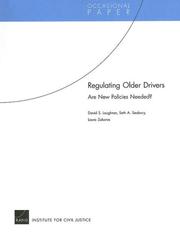| Listing 1 - 2 of 2 |
Sort by
|
Book

ISBN: 0833089811 9780833089816 9780833086044 0833086049 Year: 2014 Publisher: [Place of publication not identified] Rand Corporation
Abstract | Keywords | Export | Availability | Bookmark
 Loading...
Loading...Choose an application
- Reference Manager
- EndNote
- RefWorks (Direct export to RefWorks)
"The level of automobility, defined as travel in personal vehicles, is often seen as a function of income: The higher a country's per capita income, the greater the amount of driving. However, levels of automobility vary quite substantially between countries even at similar levels of economic development. This suggests that countries follow different mobility paths. The research detailed in this report sought to answer three questions: What are the factors besides economic development that affect automobility? What is their influence on automobility? What will happen to automobility in developing countries if they progress along similar paths as developed countries? To answer these questions, the authors developed a methodology to identify these factors, model their impact on developed countries, and forecast automobility (as defined by per capita vehicle-kilometers traveled [VKT]) in four developing countries. This methodology draws on quantitative analysis of historical automobility development in four country case studies (the United States, Australia, Germany, and Japan) that represent very different levels of per capita automobility, in combination with data derived from an expert-based qualitative approach. The authors used the latter to assess how these experiences may affect the future of automobility in the BRIC countries: Brazil, Russia, India, and China. According to this analysis, automobility levels in the four BRIC countries will fall between those of the United States (which has the highest per capita VKT level of the four case studies) and Japan (which has the lowest). Brazil is forecasted to have the highest per capita VKT and India the lowest." -- "Abstract" on web page.
Transportation, Automotive --- Automobiles --- Automobile drivers --- Business & Economics --- Transportation Economics --- Social aspects --- Drivers, Automobile --- Autos (Automobiles) --- Cars (Automobiles) --- Gasoline automobiles --- Motorcars (Automobiles) --- Automotive transportation --- Highway transportation --- Motor carriers --- Motor transportation --- Road transportation --- Automobile occupants --- Motor vehicle drivers --- Motor vehicles

ISBN: 1281180793 9786611180799 083304284X 0833041940 9780833042842 9780833041944 9781281180797 6611180796 Year: 2007 Publisher: Santa Monica, Calif. : RAND Institute for Civil Justice,
Abstract | Keywords | Export | Availability | Bookmark
 Loading...
Loading...Choose an application
- Reference Manager
- EndNote
- RefWorks (Direct export to RefWorks)
Are older drivers posing an increasing risk to the public? If they are, what options should policymakers consider to mitigate that risk? This research offers a new perspective on these questions. Using an innovative approach to estimate the extent to which older drivers are on the road and their riskiness compared with drivers of other age groups, the study finds that older drivers (those 65 and older) are slightly (16 percent) likelier than drivers aged 25 to 64 to cause an accident and that they pose much less risk to the public than do drivers aged 15 to 24, who are nearly three times likel
Drivers' licenses. --- Drivers'' licenses. --- Older automobile drivers. --- Risk Assessment. --- Traffic regulations. --- Traffic safety. --- Drivers' licenses --- Older automobile drivers --- Traffic safety --- Risk assessment --- Traffic regulations --- Automobile Driving --- Risk Assessment --- Risk Reduction Behavior --- Public Policy --- Aged --- Safety Management --- Accidents, Traffic --- Safety --- Risk --- Epidemiologic Measurements --- Social Control Policies --- Risk Management --- Organization and Administration --- Behavior --- Adult --- Human Activities --- Accidents --- Probability --- Social Control, Formal --- Behavior and Behavior Mechanisms --- Policy --- Health Services Administration --- Accident Prevention --- Public Health --- Anthropology, Education, Sociology and Social Phenomena --- Age Groups --- Social Sciences --- Statistics as Topic --- Health Care --- Sociology --- Environment and Public Health --- Psychiatry and Psychology --- Health Care Economics and Organizations --- Persons --- Named Groups --- Health Care Evaluation Mechanisms --- Epidemiologic Methods --- Quality of Health Care --- Investigative Techniques --- Analytical, Diagnostic and Therapeutic Techniques and Equipment --- Health Care Quality, Access, and Evaluation --- Law - U.S. - General --- Law - U.S. --- Law, Politics & Government --- Government policy --- Evaluation --- Evaluation. --- Analysis, Risk --- Assessment, Risk --- Risk analysis --- Risk evaluation --- Automobile driving --- Highway safety --- Road safety --- Traffic accidents --- Aged automobile drivers --- Automobile drivers --- Automobile drivers' licenses --- Automobiles --- Driver licenses --- Motor vehicle drivers --- Motor vehicle operators' permits --- Motor vehicles --- Operators' permits, Motor vehicle --- Safety measures --- Prevention --- Licenses --- Public safety --- Traffic engineering --- Transportation, Automotive --- Point system (Traffic violations) --- Collision avoidance systems
| Listing 1 - 2 of 2 |
Sort by
|

 Search
Search Feedback
Feedback About
About Help
Help News
News